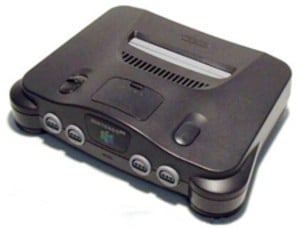
However, given the current success of the DS and Wii, it is perhaps too easy to forget that it was achieved through no less than a baptism of fire lasting two hardware generations; it is the story of an unfortunate refusal to accept the shifting paradigms of the industry in the face of new competition, a lack of flexibility as regarded quality control and licensing, and a series of business decisions leading to the mass exodus of the most important third-party developers to a platform (the PlayStation) that did not even exist two years prior. This is the tumultuous story of the N64.
To understand the positioning of the N64, it is important to comprehend Nintendo's company culture at the time. Through the stringent licensing statutes associated with the NES, Nintendo effectively monopolised the software industry for a generation. The deal was simple: either you developed solely for the NES (or Famicom, as it was in Japan), or you did not develop for it at all. Through this arose some interesting situations, with third party games occasionally being licensed and reprogrammed by first-party companies to circumvent the inability of the original developer to port their games to other hardware (the Mega Drive port of Ghouls 'n' Ghosts being a case in point). By the time various lawsuits relating to monopolistic practices in the USA had borne fruit - preventing Nintendo from legally continuing its licensing schemes - the effect was already near-total, and the NES was practically the only machine on the market.
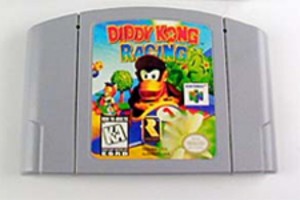
Nintendo also kept a close eye on the quality of software produced, affording only those it thought worthy with the necessary "Licensed by Nintendo" seal, and unlicensed games were not treated kindly. Nintendo was the only company capable of mass-producing the carts for its machines, and developers had to buy in tremendous amounts to assure decent per-unit prices, but this of course meant development costs grossly inflated by the cost of the medium. In the days of the NES, this was irrelevant, as other hardware suffered the same limitations. By the time the fifth generation had rolled around, beginning in 1995 with the Sony PlayStation and Sega Saturn, the realities had changed.
The move to optical media had begun in earnest in 1993, with early 32-bit consoles like the 3DO Interactive Multiplayer and the Commodore Amiga CD32 relying exclusively on it, though CD add-ons had been available for previous consoles such as the Sega Mega Drive and the TG-16. Indeed, as has often been noted, the original PlayStation was born from a failed co-operation between Nintendo and Sony to build a CD-based add-on for the SNES. The first two major hardware players to come to market with 32-bit machines, however, were not available world-wide until 1995, the successful debut of the PlayStation - with its edgy marketing and teen-oriented games - being followed by the arguably less successful "surprise" launch of the Sega Saturn.
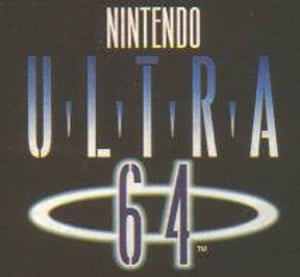
Nintendo had, in 1993, been approached by CGI computer manufacturer Silicon Graphics with a hardware architecture that SGI had developed for the console market. After several failed pitches to other companies, SGI and Nintendo agreed to develop the console, codenamed "Project Reality" (due to the purported quality of its graphics), and the announcement was made in 1994, with a speculated release worldwide in early 1995 to compete with Sony and Sega.
The SNES was still the dominant console on the market at this point with a user base of over 40 million worldwide, and an abundance of quality third party titles in addition to the first party releases Nintendo had been long famed for. Viewing the resultant battle between its two competitors from afar, Nintendo took the faithful decision not to follow suit - though their console would be 3D-based, like the PlayStation, it would forego optical media for cartridges, Nintendo citing advanced compression technologies and familiarity with the technology to assuage the near-immediate criticism this decision attracted. CDs, they argued, were not only slow to load, and difficult to engineer proper anti-piracy devices for, but the requirement for large (for the time) amounts of RAM in the console to load games into prior to playing would cut into back-end profits on console sales. Instead, it was decreed that the new machine, codenamed Ultra 64, would maintain Nintendo's market dominance through superior technology, not untested media.
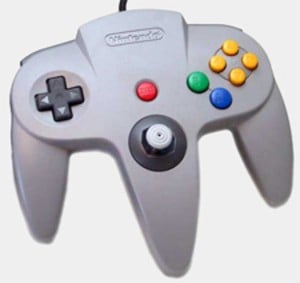
Nintendo also unveiled the novel control pad for the new machine, which was notable not only for being the first mainstream controller with and analogue stick, but also for it's 'trident' design, which allowed the hands to adopt several configurations for different types of games.
Third-party developers were not amused. Though initially keeping quiet on the issue, the realities of Nintendo's decisions was nevertheless crystalline in its clarity; Nintendo would produce the cartridges, and third party developers would have to pay exorbitant prices to buy them. Not only that, but as customers, they would never be able to match the prices Nintendo could set itself on larger games, which would have to cost more in order to cover the manufacturing costs of the medium, solid state memory. Whereas PlayStation games had been selling at reduced prices compared to SNES games, secondary to the low mass-manufacturing cost of CDs, Nintendo's cartridges would not have such an advantage. Also, whereas bulk buying of CDs meant an unsuccessful game was a cost that could be absorbed, the same would not necessarily be true here. Subsequently, a large number of developers jumped ship, swayed by the creative opportunities of the vast amounts of storage on CDs and convinced by financial consequences.
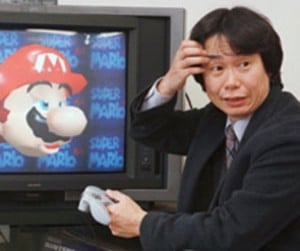
After being dubbed the Ultra 64, the console was finally introduced in late '95 in Japan as the Nintendo 64 (often shortened to N64) due to licensing issues with the Ultra name, though the North American release did not happen until September 1996, and the PAL release even later, in March '97.
Aware that the machine would require a stellar game to show off its capabilities, Shigeru Miyamoto was granted a team of elite Nintendo programmers, and set about working on the first 3D iteration of the famous Mario franchise. Super Mario 64, released together with the console, was quickly hailed as one of, if not the, greatest games of all time. Early criticism of the PlayStation had centred on Sony's lax licensing, which had meant the market was flooded with PlayStation games, though not one had yet to be considered a true 'killer app'. But the attractive price of the PSX (with Sony taking a hit on every machine sold in the hopes of making its money back on software licensing fees) combined with the sheer wealth of titles available by the N64's release had led to a large installed user base.
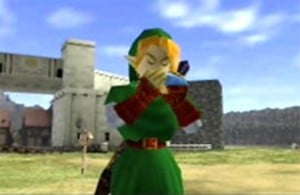
Nintendo clarified its intended marketing position relating to its competitors early on; their console was, unlike the Saturn and PlayStation, distinctly aimed at a younger market from the outset. Having understood the likely dearth of third party development, Nintendo went looking for partner companies to form a 'dream team' and involved them in the development of the first batch of titles, almost all under the watchful eye of Shigeru Miyamoto. The resulting games, including Pilotwings 64 from Paradigm, were extremely well received both critically and commercially.
Nintendo's focus on first and second-party titles quickly became overbearing during the console's lifetime, with the later dearth of titles being attributed to the mass shift away from Nintendo's platform. But despite this, the unbridled creativity available at Nintendo itself could not be denied. Despite being a distant second in the sales fight against the PlayStation (the Saturn having failed at the first hurdle) with under 35 million sales against the 105 million of the original PlayStation, the N64 was nevertheless home to several flashes of undiluted genius, the likes of which the PlayStation arguably rarely, if ever, witnessed. The aforementioned Super Mario 64 and Pilotwings 64 set the ball rolling, but this high-quality (though low-volume) output continued throughout the life of the console and included what is still regarded as the greatest game ever made, The Legend of Zelda: Ocarina of Time. Another company that had been taken under Nintendo's wing, Rareware, produced a series of games to this day remembered very fondly, including the James Bond license Goldeneye 007 and the Banjo-Kazooie series of 3D platformers.
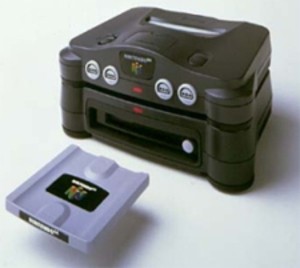
During the development and launch of the console, a rewritable optical disk format was proposed. This idea, the 64DD, never came to fruition in the way originally imagined, and though released in Japan much later than intended, was to become nothing more than a footnote in the history of the N64. Most of the games intended for it having been moved to ever-larger cartridges, notably including Zelda: OoT, and those that were eventually released were mostly expansion packs for existing games.
Today, the N64 holds a strange place in the hearts and minds of gamers, its perceived shortcomings at the time having been dimmed during the intervening years in light of the high quality of many of its games. Having been seen as technically archaic in its choice of medium and with games priced sometimes twice as highly priced as those from the competition. The sales figures certainly tell a story, but it can be argued that many of the N64 titles, particularly the first and second-party games, have stood the test of time distinctly better than software from contemporary rivals.
A console considered too expensive, too narrow in its demographic focus, and too difficult to program for during its lifetime, the N64 now stands towering in the memories of gamers due to the one thing that truly matters when all is said and done: its games.



Comments 52
Well written article. I own a Wii, but have just purchased a secondhand N64 console with 15 games (worked out to be far cheaper than buying virtual console games) Many games such as Diddy Kong and Banjo Kazooie are still very entertaining. I always knew the N64 graphics were better than the PS1, but I couldn't figure out why the PS1 was so popular. Now I understand the whole cartridge/cd cost thing.
well said indeed, I personally hated the controller, but i loved the fact there were no load times and no need to buy a memory stick. But your right, it all boils down to the games, in which the N64 had the best of.
I wanted 2 buy an N64 as well but my Wii plays N64 vc games..... so there is no point
Very well written! I had the N64 back in its heyday, but switched to the PS1 when Final Fantasy jumped ship to be a Sony exclusive. Hopefully this article will be continued to include the Gamecube's history.
Well Written indeed. I Purchased an N64 last summer, now have most of the best games for it. I missed out first time round but consider the N64 to be greater than the Playstation due to superior games, a greater controller, and the original ideas that Sony lacked.
Mario and Zelda Rule
Ross, you'll never play some of the great N64 titles on VC - Goldeneye for example, Perfect Dark, Conker's Bad Fur Day... plus why wait for Paper Mario when you can go out there and buy it today!? Its just a little extra but its well worth it if you haven't played it before.
Bravo, bravo! Very good article, balanced about the console's positives and negatives, and reminds me of the good ol' days. *Hugs N64*
I was an owner back in the day, we opted for it over a Playstation. It did mean expensive games of course, and it didn't have the glamour of third party that Sony's grey fella did, but when Nintendo developed an N64 game, it was usually not only excellent, but easily among the best you could get in the late nineties.
The Playstation is an excellent console, I certainly won't deny that (Although I was so smug seeing games having to load when I played it over a friend's house; my games didn't have to do that! >=]), but for the memories, the classics it produced and the clumsy but still well designed controller, the N64 remains the best 32/64bit console for me!
Bass X0 - Goldeneye isnt in the same boat as perfect dark, conker's bad fur day. so dont be so pessimistic by saying something like "you'll never play", Activision IS a 3rd party publisher/developer after all. And even though rare made a game in the goldeneye franchise doesn't mean they can tell activision what they can and cant do with their james bond license. and three, the fact the Reggie expressed interest in getting the game and saying "the pain is worth the gain" should be a little convincing to atleast say that Nintendo knows there is a possibility.
Though it will likely be more than $10, Goldeneye will be on VC eventually, mark my words!
oh ya... i see that Nima wrote this, am i to assume that it is the same iNma in the forums?
Very well written article. As a kid growing up, i had never even seen a playstation. The only other consoles i saw that were not Nintendo were Sega's. The very first time i saw a sony console would have been 2001 when my brothers friend had just gotten a playstation 2. I think that the N64 was a great console, and i have many fond memories of playing it. Cheers to the 64!
Excellently written article. Nice one iNma!
I never had an N64, I was a Playstation man. But then again, back in the day, I wasn't a gamer. Boy do I love the VC hehe.
They were right about the piracy the Playstation was flooded with copied software towards the end of the 90s.
I heard that they were trying to get GoldenEye on VC too but I'm going to retain my doubts until its actually done.
I don't know if there's been anymore news seen Reggie's MTV soundbyte last December:
http://www.vc-reviews.com/news/15/n64-goldeneye-on-virtual-console.php
Still we live in hope eh?
I got my N64 for christmas one year, and man, I loved that thing. However, 1 day of playing FF7 at a friends house, and I went out and bought a PS1 the next day. They both had their strengths and weaknesses, and I have fond memories of both systems. Poor Saturn...
I loved my N64 back then because I had the most games for it: Donkey Kong 64, Paper Mario, Hey You Pikachu!, Super Mario 64, Mario Party 1, 2, 3, Diddy Kong Racing, Mario Tennis, and Tom and Jerry: Fist of Furry. That's why I hope Nintendo releases all of my ol' friends again. I can't believe I sold them for a PS2!
Still, with the PS3 failing, I wonder if Sony will become a developer like Sega. Who knows, maybe we could see PS1 games on it in the future.
That was a nice article there, and I couldnt help but to agree on some aspects there.My gripe with the N64 at the time was that it's games were hilariously exspensive comapredto the PS1's titles and in retrospective there was too few gmes released at one time (well, stellar ones anyways). What I loved (and still do) about my N64 is that it had some of the best games I have ever played and despite its shortcomings it remains my fave console as it was also the first console I played till the birth and death of and more importantly games such as Perfect Dark, LoZ: Marjora's Mask, Conkers Bad Fur Day, Mario Tennis etc mademe happpy.
What I find ironic is that of the three big points of death ypou mentioned at the end "expensive, too narrow in its demographic focus, and too difficult to program " Sony seem to have two of these already which isn't exactly a great start to any console >_>. Now Nintendo have the unmentioned fourth problem which is a "lack of power" while M$ seem to be in the driving seat with no aspects that could hinder their sales (besides the poor quality of the consoles themsleves that is)
I was so that N64 kid screaming his lungs out in joy when I got my N64. loved that thing. still play it cus of pilot wings and Star Fox 64
Nintendo Sixty-FOOOOOOOOOOUR
http://www.youtube.com/watch?v=DpJyG7B6tAI
Let's raise a glass.... to the N64 folks.
nicely done Nima.
There is bound to be some games not to see the light of day on the VC, wether it be due to licensing problems or maybe too obscure. My N64 is still ready to play though and some of the bigger games just have that total replay value that PS1 games lacked.
I myself have Super Mario 64 on the N64, the VC and the DS and have enjoyed playing it on all, not to mention the Zelda games.
It would be good to see a faster flow of N64 games on the VC but if you check out these games on lesser emulators you will see how well adapted they really are when ported to the VC.
The N64 GoldenEye (a killer app if I've ever seen one) Pack was the first Nintendo console I ever owned. It's design is just perfection (I *still* love that controller), even if the graphics look like you have cellophane over the TV at times. Needless to say, a GameCube, GBA, DS and now Wii have followed. When will we see Pilotwings 64 on VC? And does anyone know the position on the brilliant Blast Corps? Is it Rareware or is it a Nintendo property?
The good old N64 days, I adored the games that came out for it. Every time I play my N64 it brinfgs back good memories of the 1990's and the turn of the millennium (2000). Anyway, dies anyone have any idea when Majora's Mask will be released on the Virtual Console? It's the only Zelda game not on there, and I desperately want it.
mario tennis,mario golf,mario 64,dk 64,kobe bryant basketball,namco collections,etc...what a great console!my n64 is still functioning,i am happy. mortal kombat trilogy....toasty!
With many of the N64 games, I still sit down and play with them even though I already have completed them, that is how fun they are.
Because it is not how long it takes to finish them that makes them great games, but it is how long you still play them after you finish them that is the key to making great games.
And the N64 winns with that hands down.
Also some of my best N64 games were Zelda OoT, Mario 64, Pokemon Stadium (1 & 2, with the Pokemon Gameboy Games played though the Transfer Pack), Snowboard Kids, Conkers Bad Fur Day and Jet Force Gemini.
Perhaps the only bad thing about the N64 was that there was no RPGs, no Metroid and there was no good Gameboy to N64 link (besides from the Transfer pack but that only worked for the Pokemon Games).
But if you think of how the Gamecube fared in the market compared to the PS2 and the XBox, then you have to say that the N64 was still a great console in the end.
A very well-written article. Definitely brought back memories of Junior High and High School.
The Nintendo 64 was the reason Square Soft (now Square Enix) went to make Final Fantasy games for the PlayStation. The cartridges were limited, blurry graphics and not enough third-party support. Still, the N64 had great classics: Super Mario 64, Star Fox 64, Wave Race 64, Banjo-Kazooie, Kirby, the Zeldas.
To Darren Scantlebury-Watson: Blast Corps is a Rareware game. So far, only Donkey Kong Country 1 and 2 made it to the Virtual Console because DK is Nintendo's intellectual property.
Nice article. But!
After being dubbed the Ultra 64, the console was finally introduced in late '95 in Japan as the Nintendo 64 (often shortened to N64) due to licensing issues with the Ultra name, though the North American release did not happen until September 1996, and the PAL release even later, in March '97."
Wrong-o. The N64 was released on June 23, 1996 in Japan.
When are we gonna get more N64 games? I take ANY N64 game.(except Conker.)
I like to see Resident Evil 2, Jet Force Gemini, Donkey Kong 64 and Star Wars Rogue Squadron. Little chance for any of Rare's titles on VC so I am not holding my breath for those!
"the N64 now stands towering in the memories of gamers due to the one thing that truly matters when all is said and done: its games."
Amen.
"the N64 now stands towering in the memories of gamers due to the one thing that truly matters when all is said and done: its games."
Beatiful and a true statement.
I never owned or played an N64 much except at my Dentist (had Mario Kart 64), and a couple of times at my cousins playing Golden Eye. But the N64 did have some great games.
n64 lives!...through the wii!awesome!
The N64 woke nintendo up. The Videogames market Had a major shift towards 20 somthing gamers in the mid nintees. It became fashionable for older people to play computergames. Nintendo drastically read the market wrong. This compliled with the rediclous idea of STILL using carts and the cost of manufacturing them it nearly cost nintendo dear. The ONLY thing that kept them going was the Gameboy. Saying that, it produced THE game many FPS are modeled on today.....Goldeneye. The First ever fully 3-D game, Mario 64. And the best game ever Ocarina of time. I have to say the only game that has come close to that "Nintendo magic" since then was Mario Galaxy. VCR Got it spot on it's the games you remember not the system!
I actually really liked the controller. First of all, it was nicely seperated, spaced and balanced when I held and used it. It was nice to get the feel of the trigger "Z" button as you tore people apart in Goldeneye and the "arcade" layout of the buttons was fun with games in the fighting genre. Plus, it looked really cool when you had a Red, Blue, Yellow and Green controller set up for Multiplayers.
The N64 is the gretest revolution in Nintendo history, except for the Wii, because it intoduced true 3-D graphics, better games, and better everything else, the only thing greater than it is the Wii, the gamecube is still good though. If you dis the N64, GC, or the Wii your on of my biggest enemies. Games like Super Mario 64, Star Fox 64, Mario Party 1,2,3, Pokemon Stadium 1,2, Hey You Pikachu and just about anything else are great.
As Josh said, the N64 was released in Japan in '96, not '95. Also, The "surprise" Saturn launch came before the PSX launch, as it was a botched attempt by Sega to get the jump on Sony.
As for the N64's troubles, it's all about licensing costs. I remember reading in EGM a long time ago that licensing costs for a PSX game were only a dollar a disc, because CDs by that point only cost pennies to press, while a N64 cart cost somewhere around $32 dollars or so, each. Yeah, that's right, an N64 game clocked in at over 30 times the cost per unit to make. So even if the licensing costs didn't scare the publishers away immediately, they would soon realize that because of the huge costs, they could only sell their titles in smaller numbers, making less profit, and limiting the installed base because people are less hesitant to buy systems that have less support. It's a vicious cycle.
I also read later that Nintendo was able to basically cut the licensing costs in half, but the average cart was still clocking in at around 17 or 18 bucks a piece. Using the cartridge medium meant that it was completely impossible for Nintendo to ever get the same kind of third-party support on its system that Sony had.
I shared Nintendo's hatred of load times, and in fact I still do, as they don't seem to have gone anywhere in the last 13 years. At the time, I felt that the double-speed CD drives that Sony and Sega were using were too slow, and that Nintendo was barking up the right tree. Unfortunately, what both Nintendo and I failed to realize was that the costs of manufacturing and silicon at the time were far too great to overcome, and load times weren't significant enough of an issue not to compromise on. Nintendo may have publicly pretended to prefer "quality over quantity," but they would've made a ton more money had they used CDs (not that they needed it, they had Pokemon making money hand over fist).
Speaking of that quality versus quantity bull, Nintendo's so-called "Dream Team" wasn't, and they definitely weren't all overseen by Miyamoto. Nintendo didn't have any involvement in the third-party titles, like Turok (okay, you have to know that the "Dream Team" is a farce when Acclaim is a member... Acclaim!) or Mortal Kombat Trilogy. Half the announced titles didn't even come out (Buggy Boogie, from Angel Studios?). I think I still have photocopies of all the screenshots printed in EGM back in 1995 in a closet somewhere. The only "Dream Team" titles that were really critically accepted were Nintendo's first- and second-party titles.
I also have a bone to pick with Nintendo about the hardware. The SGI design utlized an R4300 RISC CPU which wasn't necessarily the best choice, and using a 32-bit data bus limited it somewhat (not to mention, called into question the accuracy of labeling it a "64-bit" system). But I can forgive that. What I can't forgive is that Nintendo made the same stupid mistake Intel would make years later, and bought into the hype of that overpriced garbage known as RAMBUS RDRAM. Nintendo could have saved money buy using more cheaper RAM and CDs. If cutting costs were such a concern, Nintendo shouldn't have tried to engineer every part of the system to use the most top-quality component they could find.
The Nintendo 64 was touted as being almost a miniature SGI workstation, about a quarter as powerful as one, according to Next Gen magazine (which might have been their January '96 issue, if I remember correctly). Well, SGI workstations aren't used for playing console games. My problem with the hardware is that it's less concerned with pushing polygons, and more concerned with making them look good. A noble thing, sure, and slightly off the path of the push-as-many-polys-as-possible approach Sega and Sony were taking, but the problem is that with the limited texture memory, those poly-prettying tricks are kind of going to waste. You can only make a muddy texture look so good, and I do feel that N64 textures were pretty darn muddy even for the time.
Then again, it introduced console gamers to some cool new stuff: z-buffering, MIP-mapping, and if I remember correctly, it was the first console to offer hardware antialiasing. And, of course, it's still got some great games, some of which will remain classics for years to come.
The N64 wasn't nearly the kind of gameplay revolution the first two Nintendo consoles were, but it really pushed Nintendo into the realm of 3D (remember, they HAD done 3D before, on the SNES, but not very much of it), and I think that they learned a lot from it, even though the Gamecube didn't do much better. It was a rough ride, but a learning experience for us all, and we still got many great gems along the way that are still, to this day, only playable on the N64. And like always, those games make it worth the price of admission.
I have fond memories of n64 because it was one of my first consoles. Now I get to download other classic n64 games.
One thing I do not get is why you think it is bad for Nintendo to have had stringent licensing policies?
Is that not what we want to do? Remove shovelware from shelves?
I still have this set up in my front room, pay it quite frequently too. I'd much rather have a wee game of Snowboeard Kids, Rocket: Robot on Wheels or ISS 64 than play most of the rubbish that's on VC and WiiWare...
i had a N64 and it broke so i buy the VC games now but i mean really, we need more N64 games on it, it is terrible, Nintendo could add Mario Party, Pokemon Stadium, Majora's Mask, Super Smash Bros, so many oppurtunities even without RARE support
Mipsymoodle i totally agree with you on that.
My N64 console broke also and one of the main reasons why I bought the Wii was so that i could play the N64 games on the VC. Unfortunatly, some of my favorite N64 games, like mario party 1, 2, 3, Conkers bad fur day, Diddy Kong racing, Dk 64, super smash brothers, beetle adventure racing, pokemon stadium, Goldeneye and even those Army Men: Sarges Heroes games would be amazing to see on the VC but have yet to see the light the day.
the N64 has got to be my 2nd favorite system of all time (right after the SNES.) N64 has some of the best games ever made. I loved all the Pokemon games this console has (except Hey you, PIKACHU.) This system also has the greatest game of all time, Banjo Kazooie. I would really like to see more N64 VC games come out. this system is a well deserved 10/10
NINTENDO SIXTY-FOURRRRRRRRRRRRRRR!!!! OH MY GOOOOOOOOOOOOOOOD!!! OH MY GOOOOOOOOOOOOD!!! OH MY GOOOOOOOOOOOOOOOOOOOOOOD!!!!
Sorry, I just couldn't help myself. Thank you muchly for the link to that video, Dazza!
Anyway, I missed out on the N64 back in the day, as I decided to go the Playstation route then, and that was mainly because my sister won one in some contest. I was pretty console-phobic back then, as I always thought home system controllers were too complicated (Keep in mind that I was used to playing the Game Boy, a system with a single D-pad and 4 measly buttons.). I played a few rounds of Spyro the Dragon, Bust a Move '99, or Crash Bandicoot now and again, but mostly just watched my sister and my cousin play. I didn't truly get into consoles until the Gamecube came out in 2001, when I was 10. The only experience I had with the 64 prior was at the occaisional trip to friends's houses. So for those reasons, I praise Nintendo for bringing this system to the Wii through VC, cuz then I can finally catch up on all those legandary games (like Mario 64, Star Fox 64, and OoT) games I missed out on as a kid.
Now can we finally have some more N64 games now? Please?
I wonder what's taking them so long to release any 3rd Party N64 games yet, I know some of you guys will probably tell me that the VC emulator can't emulate the controller pak. Well, unless I see a credible source saying that, I'll have to take the "controller pak rumour" with a grain of salt.
The N64 was absolutely spectacular, housing games like SSB, Banjo Kazooie, Pokemon Snap, Super Mario 64, Goldeneye 007, and OoT. To bad I wasn't into video games at that time
Definitely my second least favorite Nintendo system, unless the Virtual Boy is considered a Handheld. Hated most of the games on it, and even the ones that I didn't hate didn't age very well. Hated the controller and the cartridges, too. Really wish I had gone with a Saturn or a Playstation instead.
Actually, I regret having gotten a Playstation, too. At least, I regret waiting until 2001 before actually getting one. I only got a few good games for it, and honestly, I should've just gotten a Dreamcast when I was that late in the game. I almost got one a few years ago, but at the time I didn't know any good games for it, so I opted not to buy it, much to my mother's chagrin(we had to go to three different stores in order to find it). That alone made me regret not getting one, but now I regret it even more, knowing how many good games were on it.
N64 was were it was at! In my group of frieds Everyone agreed the 64 was the best. Great multiplayer that was unsurpassed for it's time, the PSX had nothing on this console!
I thank Nintendo for making the N64 as it carried throughout the 6th generation of consoles (since I didn't own a PS2, Xbox and the GameCube) until I bought my Wii around Christmas 2006. I had so many games for it: Mario 64, Smash Bros., Majora's Mask, Goldeneye 007, Conker's Bad Fur Day (EPIC), Hey You Pikachu! (I got it for a bargain in 2003), NBA Jam, Pokemon Stadium 1 and 2, Pokemon Puzzle League, Pokemon Snap, Rush 2, Crusin' USA, Quake II (My most played game on multiplayer.) and so much more.
Trust me, for the N64 to hit the VC was awesome.... Until I saw the price tag (1000 points?!) But sadly, my mom forced me to give up my N64 since I had the Wii now..... I'm not planning on getting any N64 VC games though.
But still thank you N64 for helping me survive an entire gaming generation! And thank god for my Jamaican homies who still had N64s back in the day so we could have huge multiplayer tournaments in Smash Bros. and Quake II in the summers!
Great article, personally, I think ps1 was better than the n64, mainly because of metal gear solid and ff7, but the n64 had some great games to, like goldeneye and super smash bros.
they all had good games, but the N64 had the best of them
Show Comments
Leave A Comment
Hold on there, you need to login to post a comment...